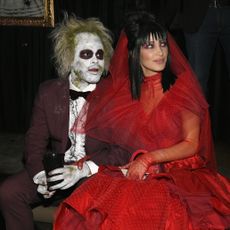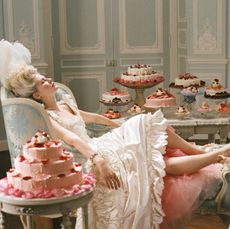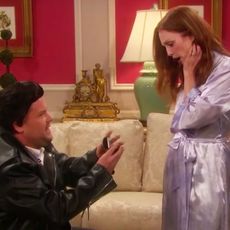This is from Lenny: Feminism, style, health, politics, friendship, and everything else from Lena Dunham and Jenni Konner. Like it? Share it with a friend.
Grace Jones and her older brother Chris, recently moved from their grandmother's watch in Pentecostal Jamaica to their parents' home in the blank suburbia of 1960s Syracuse, New York, discover they are soul mates. Specifically, inversions of each other. The teenage siblings make this discovery in gay bars in the center of the town. The flip is social: Chris plays custodian of her then-clandestine masculinity; she the keeper of his femme. "We easily passed ourselves off as twins and I wonder if we were somehow tangled up inside my mother," she writes. "I was born a little masculine, a girl with some of the boyness Chris lacked. And he had some of the girliness I didn't have." Nowhere else in Grace Jones' exhaustive and replenishing memoir, I'll Never Write My Memoirs, will such an expression of foundational identity surface.
Rather, the primary mode of Jones' memoir is a surrealist attempt to put forth yet another version of herself. In her 40-plus years in the public eye, Jones has had many. She has been a model, a disco singer, an actor, a performance artist, and an art subject, but she has remained uninterested in the career boundaries such titles imply. Jones prefers the uncategorizable. If one constant exists in Jones' career, it is the ephemerality of her artistic and personal selves.
Take the memoir's title. On the "Art Groupie" track of her fifth studio album, Nightclubbing, which came out in 1981, she sang defiantly above the metallic, staccato beat: "I'll never write my memoirs." "There's nothing in my book," the song continues. In her memoir's introduction, Jones acknowledges breaking the decades-old promise, not as a mea culpa but as a rejection of permanency itself. "I've changed," she says. About outside perception of her apathy toward marketable truth, she quips, "I'm not worried about what people think, because I think people think what they want to think anyway." From the mouth of Jones, this tautology makes perfect sense.
* * * * *
The memoir opens on Jones' fantastical narration of her own birth. Beverly Grace Jones was born in Spanish Town, Jamaica, sometime after the Second World War. (The public thinks it knows her age; "I like to keep the mystery," she demurs.) She was the third child of young Marjorie and Robert ("In my own uprooted newborn way, I probably cursed," she recounts, impossibly). When her parents moved to America, she and her siblings went to live in the foothills with their grandmother, whom she never names, and their step-grandfather, the God-fearing, fear-inducing Mas P. Grotesque faith compels Mas P to beat the children regularly; still, young Beverly Jones finds secret moments to practice her running and her now-trademark hula-hooping. "I kept the hoop moving around my whole upper body without it falling down, spinning it around and around like it was a form of protection."
When she joins her parents in New York, at age 14, Beverly begins to go by Grace. This was a nominal change, but it fits chronologically to mark these adolescent years as the time she became Grace Jones as history recognizes her. With the blessing of her lenient mother, she plays in the Maybelline her austere father abhorred: "I was doing my own makeup. I was trying to dress stylishly. I would wear two pairs of false eyelashes. Like the Supremes, whose lashes were very heavy, like feathers brushing their cheeks."
Stay In The Know
Marie Claire email subscribers get intel on fashion and beauty trends, hot-off-the-press celebrity news, and more. Sign up here.
Jones' earliest experiments with makeup and masquerade drew from the prima-donna sweep of Diana Ross and the other '60s 'Ebony' fixtures.
Jones' earliest experiments with makeup and masquerade drew from the prima-donna sweep of Diana Ross and the other '60s Ebony fixtures. Those were the girls available to her in her small town upstate. A few years later, she descends on New York City. Dutch supermodel and businesswoman Wilhelmina Cooper discovers her at 18, slick with onyx beauty that even Paris hadn't yet colonized. Jones' career as a couture model, a kind of template for the imaginations of designers like Kenzo Takada and Claude Montana, provides her the arena to extend her mask-play from makeup to garments.
Jones goes further; she chases disembodiment recreationally too. Andre, the hairdresser on 57th and Madison, f--ks her so creatively that she considers dying. "We swallowed each other up inside the body of love." With Christ, at the Hippopotamus "a 54 before 54 on 60th and Lex," she takes acid that leaves her tripping for two weeks. Somewhere near sober, she lands in Paris for a number of modeling gigs with photographers who are invariably friends with Helmut Lang. Lang's friend Hans Feurer takes intense close-ups of her lips and teeth for Vogue Homme, achieving another kind of disembodiment that Jones ponders might be humiliating when designed by a white man. Granted, as you can probably guess, she is too proud to be rightly humiliated, a fact Simon Cowell and Jack Nicholson and other equally proud men in her celebrity-framed world find out, hilariously.
Grace Jones is quite funny, a little morbid. I believe every outrageous, nonchalant anecdote she offers and am swayed by her paranoias. I could go on forever if I shared each of her wild stories, but here are my favorites: In 1979, Debbie Harry and Andy Warhol threw her a baby shower at a nightclub called Garage. In the '80s, she saw the same therapist as Nancy Reagan. Maria Shriver gave her the death stare because she was late to Shriver's wedding to Arnold Schwarzenegger. She f--ks any man she likes while simultaneously arguing that the feminist sexual liberation of the '70s was male heterosexual conspiracy. She regards most white feminist movements as a smoke screen for male insurgency. She cannot divorce the much younger man she married at her parents' Syracuse home, Atila, because he disappeared not long after their wedding. She's still legally married to the guy. What I can't believe is her claim that Rihanna, Lady Gaga, Kanye, et al. are emulating her; I don't think any of her lives are plain enough to be successfully tracked.
* * * * *
Since Jones ascended into the diva canon, her relationships with her three main artistic collaborators—the photographer Jean-Paul Goude, the music producer Chris Blackwell, and the artist Andy Warhol—have had a racist and sexist interpretative hold on the public's idea of her career, in each instance relegating her to a vessel for their production. That understanding had always seemed weirdly Victorian, which the book confirms. It's delightful, really, to read Jones writing of the time she spent with these three men with no more import than any other person in her life. Their male hysteria is well-documented—Goude's demonstrated desire to break her body in photos during postproduction; Blackwell's loving, pushy insistence that recording engineers allow her to do whatever she wanted on her tracks even when she didn't exactly care; Warhol's employing Dolph Lundgren as his sex surrogate. The book, however, runs and runs quickly on the current of Grace Jones' ego.
There is one pivot point, however, when the text slows down. Jamaica. Beyond famous, now l'infâme, Jones goes back home to deal with the ghosts of her childhood. The death of the religious and religiously abusive Mas P clears the vistas of Kingston and Spanish Town of the ugliness he wrought. She writes, "My god. It is not that fearful, awful place that we fled." It is ganja, jackfruit, açaí, and saltfish. Jones' return and subsequent embrace of her home island stands out, starkly beautiful, from the vaguely wry tone of the rest of the book. The homecoming provides Jones, whose physical blackness had rendered her exotic in Western cultural space, with a new, ancestral way of sourcing her idiosyncrasy. Like her theory that her androgyny comes from her brother Chris, not Vogue Homme, Jones' reunion with what she calls "her Jamaican side" helps her understand her form and her thoughts outside of a white industry's appraisal of those phenomena.
* * * * *
In the months preceding the publication of I'll Never Write My Memoirs, Jones went on a publicity blitz. On one hand, the interviews were largely promotional, meant to establish Jones as a progenitor of 21st-century ambient, androgynous, amorphous performance pop. On the other hand, they were extensions of this provocation the book puts into the celebrity ether: "What follows is the me that I have made up." Though the 379-page tome follows a strict chronology, a sense of spontaneity freights the narration. The impeccable attention to detail, to rendering geography and feeling, might read like Jones' reliability. Really, it's her penchant for designing personal history, as if it were a mask rather than a ledger.
Memoir is an entirely strange genre for a surrealist at heart. Memoirs are complicated, usually conservative gestures. Politicians write them as civilizing bids before the inevitable vanity of running for office; celebrities write them to repudiate their vanities; now, every famous woman is writing one to prove her identity as a feminist. Jones balks at those categories. And individual artists, the ones Jones calls out and many more, are also attempting to crawl out of pop culture's idealist, isolate slots into that broad career called Artist. It is a lawless space, a lawless identity, in which Grace Jones has been sovereign since the early '70s. I'll Never Write My Memoirs comes at a critical time in the renegotiation of stars, then, and you might read the book like it is a reminder or a threat. But Jones didn't write it for anyone else. She wrote it for herself—at least one of her selves.
Doreen St. Félix is the editor at large of Lenny.
Lenny is an email newsletter founded by Lena Dunham and Jenni Konner, the creators of HBO's Girls. Subscribe now at lennyletter.com.
-
 Zendaya's Method Dressing Marathon Is Over
Zendaya's Method Dressing Marathon Is OverShe found a new way to serve in custom Vera Wang.
By Halie LeSavage Published
-
 Bitten Lips Took Center Stage at Dior Fall 2024 Show
Bitten Lips Took Center Stage at Dior Fall 2024 ShowModels at the Dior Fall 2024 show paired bitten lips with bare skin, a beauty trend that will take precedence this season.
By Deena Campbell Published
-
 30 Spring Items That Solve My Expensive-Taste-on-a-Humble-Budget Dilemma
30 Spring Items That Solve My Expensive-Taste-on-a-Humble-Budget DilemmaSee every under-$300 spring item on my wish list.
By Natalie Gray Herder Published
-
 The 78 Best Celebrity Couple Halloween Costumes of All Time
The 78 Best Celebrity Couple Halloween Costumes of All TimeHonestly, we're impressed.
By Charlotte Chilton Published
-
 22 Captivating Films About Royal Life
22 Captivating Films About Royal LifeOnce you've finished 'The Crown,' cue up one of these royally good films.
By Nicole Briese Published
-
 Who Is Jonathan Owens, Simone Biles's Fiancé and NFL Player?
Who Is Jonathan Owens, Simone Biles's Fiancé and NFL Player?"The easiest yes!" Simone wrote about the couple's engagement.
By The Editors Published
-
 The Best Celebrity 'Squid Game' Costumes
The Best Celebrity 'Squid Game' CostumesA handful of stars chose this year's most popular theme.
By Quinci LeGardye Published
-
 Rebel Wilson Recreated an Iconic Britney Spears Look for Her New Movie
Rebel Wilson Recreated an Iconic Britney Spears Look for Her New Movie"Can you tell that I’m the biggest Britney fan!"
By Iris Goldsztajn Published
-
 Taylor Swift's Lyrics Make for an *Amazing* Soap Opera, as Julianne Moore Demonstrates
Taylor Swift's Lyrics Make for an *Amazing* Soap Opera, as Julianne Moore DemonstratesThe themes are right there!
By Chelsea Peng Published
-
 Who Are Simone Biles's Parents? Meet Nellie and Ronald Biles
Who Are Simone Biles's Parents? Meet Nellie and Ronald BilesThe Olympic gymnast was adopted by her biological grandparents in 2003.
By The Editors Published
-
 51 Rare Photos From Princess Diana and Prince Charles' Wedding
51 Rare Photos From Princess Diana and Prince Charles' WeddingYou've probably never seen these before.
By Charlotte Chilton Published